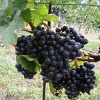
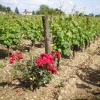


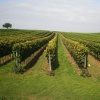
Tasting and Tranquility in Lebanon
As I set off along the main route from the airport into the centre of Beirut, I relaxed. Perhaps it was the Arabic music on the radio or familiarity of the constant car horns and the disregard for lane discipline. The horn is generally used not in an aggressive way but more of a ‘Hey! Watch out, I’m about to undertake/overtake/cut right in front of you (or ‘do you need a taxi?).
I’m on a week- long food trek around Lebanon organised by Taste Lebanon with food writer/tour guide extraordinaire/translator/timekeeper Bethany Kehdy. Bethany grew up in Lebanon making the tour a very personal experience. We are introduced to a food culture defined by regionality and local and seasonal availability that has been inspired and influenced over centuries.
Lebanon is a small country, its thin Mediterranean coastal strip, a source of the freshest of fish and shell fish, quickly giving way to the Mount Lebanon range and dipping to the fertile Bekaa Valley before the mountains rise again to form the Anti Lebanon range and signal the Syrian border.
After drinks and canapés in the bar of the rather luxurious Four Seasons Hotel we head to dinner at Al Falamanki, a delightful rabbit-warren of rooms where later in the evening heady clouds of argile smoke hung in the air as games of backgammon are played out over strong sweet coffee and potent arak. A seemingly never ending supply of dishes is enjoyed at a leisurely pace. As an aside, even the smallest café appears to offer valet parking!

Breakfast
I soon learn to pace myself as two breakfasts and 2 lunches often played a part in the itinerary! Typically, tomatoes, cucumber and olives are on the breakfast table alongside labneh (strained yogurt) and fool mudammas (bean stew). Eggs can be scrambled with tomatoes and onions or spicy sausage.
At a traditional bakery, family owned since 1948, we sample Lahm b'ajeen - the thinnest, crispiest bread dough topped with spiced lamb mince washed down with ayran, a refreshing salty yogurt shake.

‘Street’ food
Shawarma in Beirut
There was nothing inferior about the food on the go that we sampled during the week. At Lala Chicken in the Ashrafieh neighbourhood of Beirut, their famous chicken sandwich is delicious toasted flat bread stuffed, and I mean stuffed with shredded, roasted chicken and toum (garlic sauce, with extra garlic if you are so inclined). As we left to head to Boubouffe to sample their beef shawarma, a Syrian father and son passed by with a strawberry laden cart. The area has a real neighbourhood feel to it with people stopping to pass the time of day.
Boubouffe Restaurant is the last place in Beirut to char- grill the shawarma rather than use gas. The beef is marinated for 2 days in vinegar and 7 secret spices. We sampled lots of secret recipes during the week!
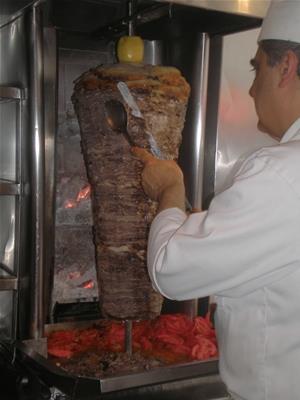

Falafel in Saida
Later in week in the southern coastal town of Saida, we sat on plastic chairs looking over to the crusader castle enjoying just cooked falafel loaded flatbread (with chilli sauce). Aromas mingled with scents from the soap shop across the road.
Sfiha in Baalbek
Moments to the stunning Roman ruins yet a world away in the tight, busy streets of the Baalbek souks in the Bekaa Valley, we visited one of the many butchers who kindly minced our chosen cut of lamb and added allspice and pine nuts. It was then over the road to the heat of the bakers who quickly shaped our meat in the dough to bake flavourful sfiha, a local pastry. I tried to watch closely to get the knack of pinching the pastry together but they were just too quick!
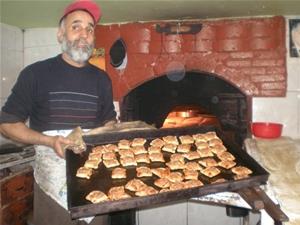

Only four ingredients…
Za’taar, often referred to as wild thyme has the appearance of rosemary (although less woody looking) and has characters similar to oregano, marjoram and thyme. Farmer, Abu Kassem has now taken to cultivating it as it’s seasonal and availability in the wild has lessened. The air is fragrant as he toasts sesame seeds and then blends with equal quantities of dried za’taar and sumac and a little salt. Za’taar mix should only contain these 4 ingredients. It became a trade mark scent during the week.
It’s the norm for the women to make up their preferred mix and take to the bakers to have it spread on dough with olive oil to make flatbreads. ‘Women of the bakery’ is a phrase born from this practice as they chat and wait for their bread to cook. Makes a change from hanging out in Starbucks!
We are in the south of the country and drive to take in the peaceful, green Litarni River, it’s too cool to picnic by the river but I can imagine the scene during the hot summer months. The views across the green hills are glorious.
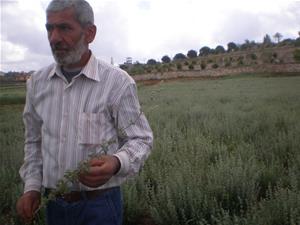

A Lebanese Brew
Founder of Lebanons first micro brewery 961 and former airline owner Mazen Hajjar gave us a great insight into his art with snippets of history thrown it. It was impossible not to get caught up in his enthusiasm We taste the beers alongside locally produced cheese, honey and organic veggies. Support for local business doesn’t stop there, they grown their own hops and support local bands and artists.
It’s not been easy, the project started the same week as the 2006 war and Mazen had no previous brewing experience. In the brewery, tanks are named after favourite comic characters- there’s Lou and Andy from Little Britain and Larry, Curly and Mo. The brewery has evolved to fill all useable space as demand has grown although beer drinking isn’t part of Lebanese culture. There are a number of brews in the range and limited edition ones too. Styles vary from fragrant, soft and easy drinking Lebanese Brew, a Pilsner style to the fresh , dry, citrusy Witbier (a wheat beer) and include a Porter, a stout and Lebanese pale Ale infused with local herbs and spices which is described as a celebration of Lebanese flavours (aah – za’taar!).
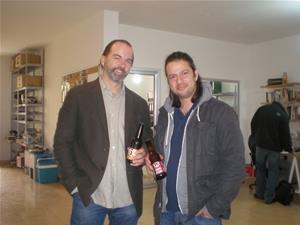

Wine Life
With a wine history thought to date back some 7000 years, Lebanon is one of the oldest producing countries in the world.
Altitude plays a part and many vineyards sit at around 1000 metres and are planted on terraces. There are now around 40 wineries in the country, mainly in Bekaa with handful in the North West, coastal influenced region of Batroun.
I visited 3 wineries on this trip – Ixsir, Domaine Des Tourelles and Chateau St Thomas. Tasting notes from these and other estates are towards the end of this blog.
Embracing Lebanese Life
In a week, I have learnt to negotiate congested Beirut traffic by making eye contact, raising a hand and striding purposely across the road.
I automatically order espresso.
I have danced until the early hours at the Music Hall night club in Beirut where 16 eclectic acts ranging from Russian to Armenian to rock to disco and salsa entertain for 10 minutes with dance music taking over during change over.
From a hilltop overlooking the med, I’ve tasted the honey from the bees who surfed the orange blossom which was distilled the make orange blossom water.
I’ve strolled the Corniche in Beirut were people jog, promenade and fish.
I’ve been entertained at a remote mountain home where I was taught how to make tabbouleh to the encouragement of ‘bravo, bravo’ as my chopping skills improved. Family and friends join together and the day is spent preparing, cooking, eating and enjoying arak and wine until the sun dips and the chill of the crisp mountain air takes over. Stars shine and blankets are needed and then we eat and drink some more.
In this captivating country, hospitality is at the heart of the culture. From a simple bowl of nuts to a table heaving with mezze made from the freshest locally sourced produce to just landed fish ready for the grill.
Lebanon gets under your skin and leaves you wanting more, I have no doubt that I will return.




Sleeping
Four Seasons Hotel, Beirut
Stylish with impeccable, friendly service and that skill of anticipating what you need before you know it yourself. I swam in the rooftop infinity pool as the sunset over Beirut. Request a high floor to make the most of the views across the city or the med.
Riviera Hotel Beirut
A prime seafront location and large lido area are the big draws of this hotel. Request a sea view room to maximise the experience.
Phonencia Hotel Beirut
This historic hotel, opposite Zaitunay Bay with it’s marina and restaurants, was every bit as glamorous as I expected. Service is attentive and helpful. We dined in Mosaic, its many counters offering a mix of Lebanese and international cuisine. They even let me try my hand at carving shawarma, I think that I should stick to my day job.
Hotel Urban, Faqra
Up in the mountains in the private ski resort of Faqra, Urban is modern with quirky touches and an alpine style. The snow had melted but the views were still great.
Eating
Chez Maguy
Hanging over the waters edge in the sleepy seaside town of Batroun, the institution of Chez Maguy has evolved over time and is seafood heaven. The menu depends on what is caught. There are colourful table cloths and outside sofas and it would be easy to lose an afternoon here. We lunch on tender grilled squid, small fried fish (you are meant to crunch on the heads), the moistest whole grilled bream and my favourite – garlic king prawns.
Save a little space for the tangiest homemade lemonade, it’s a speciality of the town and a number of stalls sell it.


Chez Zakhia
Another restaurant that maximises it’s sea front location in Chez Zakhia in Amchit where we enjoyed an unexpected but equally enjoyable seafood lunch with the Men’em brothers, the orange blossom water and honey producers.
Seza
At Armenian Bistro Seza in the Mar Mikhael area of Beirut, you almost feel that you have stumbled into someone’s lounge such is the homely feel. There are the comfiest of cushions and lacy shelf covers and other diners are close by but it all adds to the feel. This was my first experience and Armenian cuisine and I want more!
Taste Lebanon - the film!
A great insight into the trip made by James and Charles Stapleton AKA Raspberry and Jam
http://www.youtube.com/watch?feature=player_detailpage&v=RgwRWGNgD0Q
The Jewelled Kitchen by Bethany Kehdy will be released on 4th July 2013
Wine notes
Ixsir
The drive to Basbina, high in the Batroun hills, is beautiful. Ixsir, a 400 year old restored stone house with an underground state of the art gravity fed winery stands proud amongst manicured gardens. On the doorstep, there’s a botanical vineyard showcasing 21 different grape varieties to show visitors the difference. Only if you look closely amongst the vines will you see the skylights that provide a natural light (so reducing the need for as much artificial light) in the hidden winery below.
It’s no surprise given the design that Ixsir won the 2011 Green Architecture award. The underground winery provides natural temperature control.
As well as the grapes close to the winery, Ixsir source grapes from five other different terroirs at different altitudes. Syrah comes from the south of the country in Jezzine at 950 metres on steep terraces. There’s also Niha in the Bekaa at 1200 metres, Kab Elias at 1100 metres, the very low yielding Ainata at 1700 metres and Deir El Aham at 100 metres.
Grapes are hand harvested into small crates and then transported to the winery in refrigerated trucks.


Ixsir Altitudes White 2012
This is muscat and viognier with a little sauvignon blanc. It’s lively with grassy, peach and apricot notes, full flavoured and dry with a lovely minerality.
Ixsir Grand Reserve Blanc 2012
A lightly toasty and ripe peach blend of Viognier and Chardonnay with full bodied , ripe, rich flavours and well tuned acidity.
Ixsir Altitudes rose 2012
This is mainly syrah with a little Caladoc and is a serious rose – perfumed with raspberries and strawberries, mid weight and decent finish.
Ixsir Grand Reserve 2009
An intense savoury Syrah/Cabernet Sauvignon blend with notes of liquorice and blackcurrant. Very well balanced, this would benefit from some bottle age.
El Ixsir 2009
Syrah dominates the blend with some Cabernet Sauvignon. El Ixsir is limited production and is full bodied and spicy with complex fruit and oak.
Domaine Des Tourelles
Domaine des Tourelles was established in the now busy town of Chtaura on the Beirut –Damascus Highway by Francoise Eugene Brun, a French engineer, back in 1868 making it Lebanon’s oldest commercial winery.
The history of the estate is an essential part of the wine for winemaker Fauzi Issa. Bruns office remains largely untouched, with photos, artefacts (and dust) on display.
We taste the wines in the peaceful garden overlooking the vines.
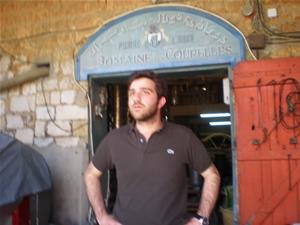

Domaine Des Tourelles White 2012
This viognier/Chardonnay/Muscat blend has become a regular in my tastings and the 2012 vintage is spot on with mineral, peach and spice notes and a lingering freshness. (M and S)
Domaine Des Tourelles Rose 2012
A Lovely, crunchy red berry inspired blend of Tempranillo, Cabernet Sauvignon, Syrah and Cinsault.
Domaine Des Tourelles red 2010
Good juicy fruit with bramble and spice aromas, this is soft and easy drinking with a lovely balance and minerality.
Domaines Des Tourelles Marquis De Beys 2010
Syrah and Cabernet Sauvignon are blended and aged in a mix of French and American oak for 18 months. This is complex and structured with great fruit and needs to sleep for a while to enjoy at it’s best
Domaine des Tourelles Syrah de Liban 2009
Full bodied, complex and concentrated with dark fruit, spice and raspberry notes. Be patient and hide this away for a while.
Chateau St Thomas
Chateau St Thomas is a family winery established on a hill overlooking the Bekaa Valley in 1990. The 50 hectare estate at Kab ELias is 6 km from Chtaura. The grounds are home to a chapel built into rocks. The barrels and bottles sleep in a deep cellar built into rocks below the winery.
Sun hats are provided at the long external tasting table but the sun has dipped behind the hillside. It was hard to concentrate on wine tasting initially with a demo of the traditional saj flat bread happening to accompany the traditional (and delicious) mezze that had started to fill the table but my will power held out and I gave the wine my total focus.


Chateau St Thomas Les Gourmets Blanc 2012
Sauvignon Blanc, Chardonnay and viognier equals crisp, refreshing and lingering with peach and orchard fruit flavours and minerality.
Les Gourmets Rose 2012
A great mezze match (as many Lebanese roses are). Fragrant with rose petals and blossom, It’s zingy, crisp and refreshing.
Chateau St Thomas Pinot Noir 2009
Lebanons only single varietal Pinot Noir is made from western Bekaa sourced grapes where year round snow capped peaks provide cool air. Intense cherry and dark blueberry aromas lead to a delicately poised Pinot.
Chateau St Thomas 2007
This is a combination of Syrah, Cabernet Sauvignon and Merlot which is French oak aged for 18 months. Fragrant with violet and mint, it’s full bodied and structured with chocolate and coffee notes.
The Horeca Hospitality and Catering exhibition in Beirut gave me the opportunity to catch up with wineries that I visited last year and the chance to try new wines. Here are a few notes to give you a taste of what’s available.
Chateau Ka
Chateau Ka Folle Blanc 2011 (Waitrose)
A crisp, zingy, grassy blend of Viognier, Muscat and Chardonnay
Chateau Ka Cadet De Ka 2010 (M and S)
A cherry and vanilla scented blend of Cabernet Sauvignon and Syrah with soft, juicy berry flavours, subtle oak and a mineral edge.
Chateau Ka Source De Ka
A structured mid -weight blend of Cabernet Sauvignon, Syrah and Merlot. It’s well balanced and rich with notes of chocolate.
Chateau Ka Fleur Du Ka 2005
A French oak matured blend of Cabernet Sauvignon, Merlot and Syrah. Spice and bramles with a touch of smoke, it’s concentrated, complex and youthful.
www.chateauka.com
Chateau Qanafar
Chateau Qanafar is a family owned estate established in Western Bekaa in 2005. Grapes are sourced at altitude from 15 hectares of vineyards owned or managed by the estate.
Paradis De Qanafar 2010
An un-oaked cherry inspired fruity blend of Cabernet Sauvignon and Syrah with minerality and some tannins to the finish.
Chateau Qanafar 2010
Aged in mainly French oak for 12 months, this Syrah Merlot blend has a dark fruit complexity with youthful tannins that need to sleep for a while.
Batroun Mountains
Batroun Mountains is a family owned and operated estate with vineyards located at altitude between 400 -1500 metres across six villages in the Batroun District.
Batroun Mountains ‘Seven’ 2012
As the name suggests, this is a blend of 7 organically grown grapes including Sauvignon Blanc and local varieties Merwah and Obeidi. It’s fresh and floral with an easy drinking minerality.
Batroun Mountains ‘Ruby’ 2011
Cabernet Sauvignon, Cabernet Franc, Merlot and Syrah combine to give ripe, juicy berry fruit characters with some structured tannins.
Chateau Florentine
Located in the Chouf mountain area, Chateau Florentine released their first vintage in 2010.
Chateau Florentine Blanc 2011
Mainly Sauvignon Blanc with 20% Chardonnay, this is good, fresh and well balanced.
Chateau Florentine Red 2010, Coteaux des Cedres
Cab Sauv, Cabernet Franc, Merlot and Syrah together give soft, brambly berries and spice. This is well balanced, has a lovely structure with ripe tannins and subtle oak.
Karam Winery
Karam Winery is based in Jezzine in southern Lebanon with vineyards at an altitude of 1300 metres and has been in production since 2003.
Karam Winery ‘Cloud 9’ 2012
A fresh and fragrant white blend of Semillon, Viognier, Sauvignon Blanc and Muscat with layers of citrus characters.
Karam Winery Arc-en-ciel 2012
A full flavoured rose with spice and redcurrant and refreshing blast of acidity.
Karam Winery Thouraya 2007
This is 100% Cabernet Sauvignon with classic blackcurrant, mint and spice aromas. It’s full bodied, ripe and rich with a good structure and aging potential.
Karam Winery Saint John 2007
Syrah, Cabernet Sauvignon and Merlot – tannins are forward and it need time, there a lot going on, it’s going to be very good.
Karam Winery Corpus Christi 2009
Classic Bordeaux blend of Cabernet Sauvignon, Cabernet Franc and Merlot. It’s intense and concentrated and oaky and needs to sleep, I predict good things.
www.karamwinery.com
Karam wines are distributed in the UK by Kingswood Wines
Chateau Khoury
Chateau Khoury is located on the eastern slopes of Mount Lebanon close to the town of Zahle. The first vines at this family owned estate were planted at 1300 metres in 1995 with the first vintage being produced in 2004. Chateau Khoury was the first estate to introduce Riesling, Gewurztraminer and Pinot Gris into Lebanon
Chateau Khoury Cuvee St Therese 2009
An interesting blend of Pinot Noir and Caladoc with ripe berry and spice scents and good juicy fruit flavours, mid weight with integrated tannins.
Chateau Khoury Symphonie 2006
A full and intense blend of Cabernet Sauvignon, Cabernet Franc, Merlot and Syrah with good aging potential.
Chateau Khoury Perseides 2007
Perfumed and intense and well balanced with great complexity and aging potential.
www.chateaukhoury.com
For details of my previous visit to Lebanon including visits Chateau Musar, Domaine Des Tourelles, Massaya, Ksara and Chateau Ka, please check out http://www.wineuncorkededucation.co.uk/blog/articles/blog-lebanon
Tasting notes from a vertical tasting of Chateau Musar in 2010 http://www.wineuncorkededucation.co.uk/blog/articles/chateau-musar-september-2010




- Telephone
- 01224 312 076
- Mobile
- 07751 520 987